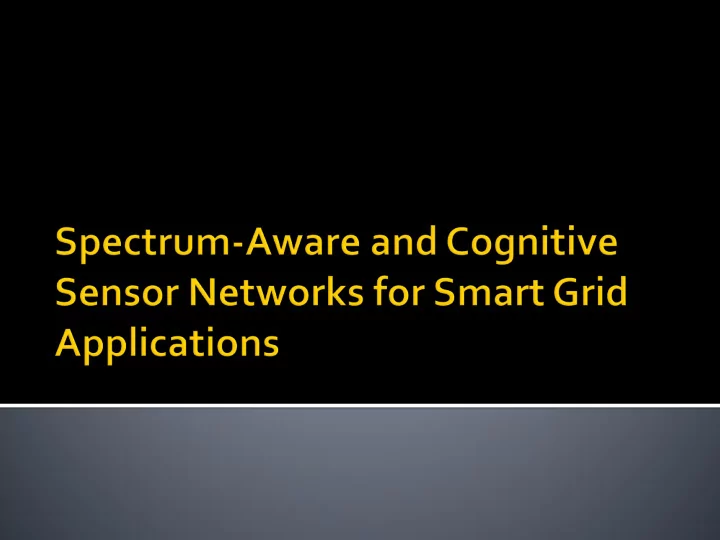

Wireless Sensor Networks Challenges in applying WSNs in Smart Grid Spectrum-Aware and Cognitive Sensor Networks Advantages of SCSN Potential applications of SCSN in Smart Grid SCSN Communication Protocol Suite Case Study Conclusion
WSNs have been widely recognized as a promising technology that can enhance various aspects of electric power systems, including, generation, transmission, utilization etc They form a vital component of next generation electric power systems, the SMART GRID How do they work?
Harsh environmental conditions Reliability and latency requirements Packet errors and variable link capacity Resource constrains
SCSNs overcome the spatio-temporally varying spectrum characteristics and harsh environmental conditions for WSN-based smart grid applications The goal of this paper is to envision potentials of SCSNs for reliable and low cost remote monitoring solutions for smart grid
Minimization of environmental effects Access to licensed and unused spectrum bands Adaptation to different spectrum utilization patterns Overlay deployment of multiple sensor networks
Remote monitoring for electric power generation systems Remote monitoring for electricity T&D Network Remote monitoring for consumer facilities
Spectrum Sensing • Consider a large scale smart grid system with large number of nodes with low cost requirement • You cannot have sophisticated spectrum algorithm or equip sensor nodes with multiple radios • Have one radio per node Challenges • Address tradeoff between energy consumption and sensing accuracy
Spectrum Decision • Ability to change operating spectrum bands • Parameter selection is an important aspect. Parameters include transmission power, energy efficiency, error rate etc • Coordination among different sensor nodes is very important
Spectrum Sharing • Transmission in smart grid environment should be coordinated by spectrum sharing functionalities to avoid packet collision • Implemented in MAC layer Challenges • Time Synchronization • Distributed Power Allocation & Spectrum Utilization • Topology Discovery
Spectrum Mobility • In presence of interference, ongoing communication can be carried on a different channel • Decision is made by spectrum decision algorithm Challenges • Mobility may disturb ongoing communication • Heterogeneity
Physical layer • SCSN node’s physical layer must be configurable in terms of operating frequency, modulation, channel coding, transmission power, spectrum sensing duration • Configuration should be based on spectrum sensing and decision results • Provide statistical information about channel conditions to upper layers
Data Link Layer • Efficient MAC and error control mechanisms • Adaptive FEC or hybrid automatic repeat request(ARQ) for error correction instead of FEC • Repetitive ARQ can block packet forwarding and cause congestion due to excessive incoming packets. This needs to be addressed • Cost vs. benefit analysis of employing FEC, ARQ, hybrid and co operative schemes should be well investigated
Routing Layer • Offers route selection through sink node to minimize interference • Spectrum decision must be performed after investigating tradeoffs between spectrum handoff and adaptation of routing layer to the concurrent operating channel • Multipath routing to benefit from path diversity • Cooperative routing schemes to increase energy efficiency on packet forwarding
Transport Layer • Reliability and congestion control become an extremely challenging task with integration of cognitive radio and sensor networks • In SCSNs the congestion control algorithm must be aware of the cognitive cycle and perform load balancing in a distributed manner • Real time requirements of time critical applications should be considered • Real time transport protocols must maximize reliability and minimize delay
Energy Harvesting in SCSN • Sensor nodes deployed in high voltage smart grid environment will need appropriate power sources • While communicating a sensor node’s power consumption is in the order of few milliwatts and it reduces to few microwatts in sleeping mode • Energy harvesting can enhance the performance of SCSN with self charging or self healing capability • Unattended energy in the environment, such as solar, mechanical, thermal etc can be scavenged to energize sensor nodes • Possible energy harvesting techniques: Magnetic Induction, Modulated Backscattering
Recent field test show that reliable communication in smart grid is a challenging task for WSN based smart grid applications due to electromagnetic interference, noise, dynamic topology changes, and fading. In this article, spectrum-aware cognitive sensor networks are introduced to provide reliable and efficient communication for remote monitoring applications in smart grid Challenges and requirements of spectrum management facilities as well as communication protocol suite was discussed
Recommend
More recommend